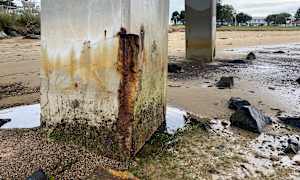RAIN and high winds along the Bass Coast have done little to reassure nervous Inverloch residents fearful their lifesaving club could soon be undermined.
Warning signs posted along the Inverloch surf beach warning of unstable dunes have fallen into the sea with little remaining of 100 cubic metres of sand dredged and dumped on either side of the lifesaving club prior to Easter.
Releasing the latest update for the Inverloch sand renourishment project State Member for Bass Jordan Crugnale MP suggested a tender will be awarded to a successful contractor between May and August this year with dune reconstruction to commence between September and November 2025.
“The Department of Energy, Environment and Climate Action (DEECA) plans to dredge 110,000 cubic metres of sand from Anderson Inlet and pump it along one kilometre of the surf beach to a height of three to four metres,” explained Mr Crugnale in a newsletter delivered to Inverloch residents.
A $10 million package recently announced by the State Government for six sites along the Victorian coastline included funding to repair and extend the geotextile container wall at Inverloch, safe access to the Inverloch surf beach, road asset protection and dune stabilisation for the planting of vegetation.
Jordan Crugnale MP anticipates these works will happen either before or during the initial dune reconstruction phase retaining natural environmental values and providing a safe and accessible beach.
DEECA was awarded funding of $3.3 million through the Australian Government’s Coastal Estuarine Risk Mitigation Program to commence on-ground works at Inverloch.
“The funding is being used for dune reconstruction and beach nourishment capital works and associated designs and approvals,” said Ms Crugnale.
“This project is a large scale, engineered restoration project which aims to rebuild part of the lost sand dune with the long-term aim of creating safe access to the beach from the Surf Life Saving Club building and Surf Parade.”
According to DEECA, the initial dune reconstruction phase will include revegetation to help hold a temporary buffer of sand in place allowing the front of the existing dune to erode rather than expose the dune behind it.
“We place sacrificial sand on beaches to protect the public foreshore and public and private assets within and behind the foreshore,” explained DEECA.
“Due to natural processes on a dynamic beach like Inverloch sand will move with the incoming tides and waves, and as it moves it will have the additional benefit of widening the existing beach.
“Some sand will be naturally shifted further offshore during larger, higher energy events, and continue its prevailing easterly movement away from the surf beach.
“Some of the sand will settle in the surf zone and possibly return to rebuild the beach during lower energy periods.”
A sand sourcing study has been undertaken to identify suitable sand for dredging.
“The aim of the study was to locate suitable sand deposits for a large-scale dune nourishment project between 100,000 and 150,000 cubic metres,” said Ms Crugnale.
Sampling of sediment on sand bars inside Anderson Inlet located coarse sand which it is anticipated will better hold the designed shape of the dunes and stay in place.
DEECA revealed offshore sediment sampling at Venus Bay located much finer sand, but it proved less effective at holding the shape of the dune and staying on the beach.
Due to the location of a submarine cable to Tasmania, there were also exclusion areas offshore that would restrict anchoring and dredging to provide an efficient supply of sand to the nourishment location at Inverloch.
Dredging within inlets and estuaries is common on Australia’s east coast according to DEECA where many estuaries function in a similar way to Anderson Inlet.
The exact dredging location is still to be decided and further investigations including core sampling of the sand bars will help determine the best and safest location.
“A large barge will pump the sand ashore,” said Ms Crugnale.
Change in the entrance is expected both before and after dredging.
The volume of material to be dredged is a small proportion of the sand present within the entrance at intertidal depths and is unlikely to change the impact of a large storm or flood event according to DEECA.
Coastal engineers Water Technology have been engaged by DEECA to prepare initial dune reconstruction and beach nourishment concept designs.
These designs are the first step in retaining natural environmental values and providing a safe, accessible beach for the Inverloch community for as long as possible said DEECA but are limited by the available budget, the length of the surf beach and the height of the existing dune and beach profile.
Former Woorayl Shire Engineer Keith Godridge and member of the Inverloch Foreshore Action Group said he could remember when the dunes were 70 metres wide and 10 metres high.
DEECA said it was important to remember the surf beach at Inverloch is exposed to high energy waves and is mostly inundated during high tide.
“The design profile may not remain as constructed for long,” DEECA warned.
This is not an indication that the nourishment will be ineffective but that the design is being developed to allow for natural adjustment by placing more material at the western end of the site and building a dune which can be reprofiled over time to maintain a buffer for existing dunes.
“Our researchers have looked at global best practice in coastal erosion management to determine the best solution for the Inverloch surf beach,” said Ms Crugnale.
Since September DEECA has met six times with community stakeholders the Inverloch Tourism Association, Inverloch Life Saving Club and South Gippsland Conservation Society who have formed the Inverloch Coastal Advisory Network (I*CAN).
Ms Crugnale said I*CAN had been briefed on the concept design in March concurring with dredge contract workshops for sand to be sourced from the inlet.









